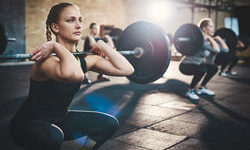How to recover actively
Whether you are having a well-deserved rest after completing the London Marathon; or putting your feet up after a mammoth cycling challenge or congratulating yourself for a first Park Run nailed, you need to understand how to recover effectively.
First steps to recovery
Once you have finished your event, hydration is key to reducing muscle soreness and helping you recover from your efforts.
Drinking water is essential for your overall health, including muscle repair. It’s good to aim for about two litres of water a day, or more if you’re active, sweat a lot or live in a warm climate.
According to a 2004 study published in the Journal of Sports Science on rehydration and recovery after exercise, you need to consume a volume of fluid greater than your sweat loss, together with consuming sufficient replacement electrolytes.
Electrolytes include minerals like magnesium, potassium, calcium and sodium, and are found in most foods. These minerals are important for your nervous system, and they also get used up during muscle contraction.
You can get enough electrolytes for muscle recovery by following healthy eating habits with plenty of fruits and vegetables.
Having a glass of milk, coconut water or a fruit smoothie after your workout can help replace electrolytes in your blood and aid recovery.
As well as drinking your way back to feeling fresh, eating the right things at the tight time is essential.
What to eat after crossing the finish line
Straight after your event, grab a snack containing carbohydrate and protein. This replenishes energy levels and speeds up muscle repair.
A number of sources of research suggests the body is most effective at replacing carbohydrates and promoting muscle repair and growth in the first 60-90 minutes after you exercise. Although this continues for another 12-24 hours, maximising your recovery in that first 90-minute window is a great idea.
The options for quick, healthy snacks to replenish your energy stores are endless — you could whip up a smoothie ahead of time, have some fruit with yoghurt, enjoy peanut butter or eggs on toast, or opt for a protein powder shake if you’re in a rush and won’t have the chance to eat for a while.
If you follow a plant-based diet, make sure you eat plenty of high-protein foods throughout the day such as nuts, tofu, quinoa and beans to give your muscles the nutrients they need to repair.
Recover actively and not so actively!
Stretching, using a foal roller and elevating your legs are all ways to a speedier recovery and a reduction in DOMS (the delayed onset of muscle soreness).
Tight hips are a common issue for runners and cyclists, so taking the time to stretch and foam roll can help reduce any discomfort, improve flexibility and support your muscle recovery.
It’s typical to spend most of your time with your legs down, whether it’s sitting, standing, lying down, walking or running.
Elevating your legs or practising the legs-up-the-wall yoga pose can help with blood flow, swelling and the circulation of bodily fluids. Trying some calming yoga poses may also help to improve circulation. Talk to our Yoga experts for more advice.
Don’t be shy with your rest days
All the evidence suggests you should do active recovery in the days following your event. This involves light movements such as walking, jogging or yoga. This keeps the blood circulating and removing metabolic waste from your body as well as transporting nutrients to the muscles.
However, you should also schedule some complete rest, a few days after your event. This gives your body time to adapt and recover fully. Rest days should be part of your general fitness routine. By giving your body one day of complete rest every 7-10 days, you will feel the benefits as your muscles have time to recover from the constant stress they are under when you train or compete.
Listen to your body
While there will be loads of advice on recovery from all sorts of sources, (including this article), the best source of knowledge is your own body.
Sometimes during or after a workout, certain areas of your body might feel tighter. These imbalances can occur as a result of factors such as your lifestyle, habits, anatomy and previous injuries.
For example, if you’re right or left-handed, one side will usually be stronger than the other and the weaker side may feel tighter. You might have tight shoulders from working at a computer all day, or a weak knee from an old running injury!
Take the time to focus on how your body feels — then you can tailor your recovery based on what your body needs. You might spend a little extra time stretching one area that’s tight and pay some attention to how it feels during your next workout.
Listening to your body also means knowing when to rest or reduce the intensity of your workouts, even if your training program or fitness watch says to keep going!
Only you know how you truly feel – both in relation to fatigue, soreness and enthusiasm for your training. To avoid burnout or overtraining, be aware of telltale signs like poor sleep, fatigue, lowered immunity or constant achy muscles and give your body the aftercare it needs.







